Grand Junction Field Office – Wildfire Mitigation & Education
The Grand Junction Field Office primarily works with landowners and federal, state and local agencies in Delta, Garfield, Mesa, Pitkin and Rio Blanco counties. We provide technical assistance for wildfire mitigation around homes and in subdivisions.
Quick Links
- Protect your Home, Property & Forest
- Things to Consider when Creating a Defensible Space in Western Colorado
- Community Wildfire Protection Plans
- Fire Restrictions
- Partners
Fire is a part of forest ecology. It is not a matter of if it happens, but when it happens, especially in Western Colorado. Low-intensity fires reduce fuel buildup, thus helping reduce a forest’s susceptibility to insect infestations and disease outbreaks. Additionally, fire helps recycle nutrients back into the soil and creates a fertile environment for seeds to germinate. Forest fires can also enhance wildlife habitat, improve access and overall appearance.
Excessive fire suppression and fuel buildup on the landscape have negative impacts on forest health and the humans and wildlife that inhabit the area. However, land managers and homeowners can take preventive measures to reduce the occurrence of catastrophic wildfires. Such actions include:
- Clearing dead and downed materials
- Thinning tree stands to reduce density
- Removing other hazardous fuels
Allowing naturally occurring fires to burn without interference or applying fire through prescribed burning can help prevent intense crown fires and maintain a healthy forest.
Protect your Home, Property & Forest
Homeowners can take steps to protect their property and reduce the risk of a wildfire destroying their home. Preventive measures include clearing excess fuel, creating defensible space around their home and using Firewise practices.
There are steps that homeowners can take (50 KB PDF) prior to leaving the home due to a wildfire. These steps should only be taking IF there is time to do so. Follow the directions of your local sheriff or fire department personnel.
In rural areas, a residential fire can spread into the wildland and there are some steps homeowner can take place to mitigate a fire from spreading (120 KB PDF), such as having a sprinkler systems, ensuring your smoke alarms are working and having a fire extinguisher. These things can make a difference, especially against small fires.
Due to the arid climate and fire-dependent forests in Western Colorado, many homeowners and landowners may be particularly vulnerable to wildfires. It is important to keep this threat in mind when buying or building a home. Two factors have emerged as the primary elements of a home’s ability to survive wildfires: having fire-resistant roofing, siding and porch materials, and creating a wildfire defensible zone around the home.
Fire embers can travel a mile or more in front of the main body of fire. Your home’s construction can be a KEY factor in its ability to survive a wildfire. See the following documents and/or links for additional information on fire embers and how to prepare your home:
- Be Embers Aware from Texas A&M University (1 MB PDF)
- Be Ember Aware website from University of Nevada, Extension.
- Be Ember Aware > Will your home survive when the embers arrive? Created by the University of Nevada, Extension (PDF).
“Hardening a home” is a term used to describe the retrofitting process that reduces a home’s risk to wildfire. This involves using non-combustible building materials and keeping the area around your home free of debris. As a homeowner, you must look at your home’s construction and where leaf litter collects. If you only focus on removing trees and vegetation, you are missing a key component in your defense against wildfire.
Some of the suggestions and information in the documents below can be done to existing homes. If you are planning building a home in the WUI – the wildland home interface, there are some important decisions you can make to reduce the flammability of your home. These actions can cost less if you include it on the front end of construction and not have to retrofit your home later.
- Researchers at the University of California put together a publication on Home Survival in Wildfire-Prone Areas and Building Materials and Design Considerations (5 MB PDF)
- The Texas A&M Forest Service created a document on Fire Resistant Materials for Home Repair and Construction (2 MB PDF)
Defensible Space – Home Ignition Zone
Defensible space and the Home Ignition Zone are part of the same concept. Newer publications are changing their terminology to use Home Ignition Zone to include not just the vegetation around the home but also the home itself, and other structures or attachments like decks, deck furniture, wood fences, and other outbuildings. Home hardening is also an important component of the Home Ignition Zone (see the section above).

This area around a home or other structure should be modified to reduce fire hazards. Both natural and man-made fuels are treated, cleared, or reduced to slow the spread of wildfire. The home is assessed to reduce the potential of structure ignition by looking at the material, design, and areas where embers can enter the home.
Creating defensible space also works in the reverse, and reduces 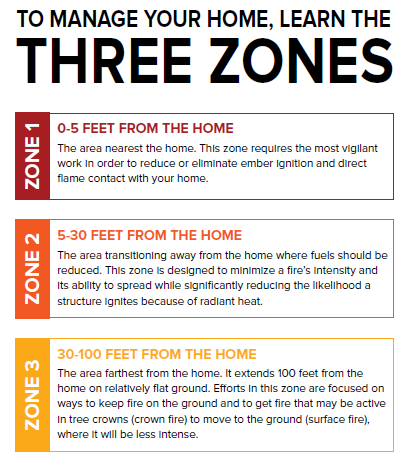 the chance of a structure fire spreading to neighboring homes or the surrounding forest. Defensible space gives your home a fighting chance against an approaching wildfire.
the chance of a structure fire spreading to neighboring homes or the surrounding forest. Defensible space gives your home a fighting chance against an approaching wildfire.
Creating an effective defensible space involves a series of management zones in which different treatment techniques are used. Develop these zones around each building on your property, including detached garages, storage buildings, barns, and other structures. A summary of the zones is below, view the Home Ignition Zone Guide (2.7 MB PDF) for additional information.
The area called Defensible Space or the Home Ignition Zone has three zones.
Zone 1 is the area immediately around the structure, starting at the edge of the flammable part of the structure (roof line or deck) and extending 5 feet. This zone requires the most vigilant work in order to reduce or eliminate ember ignition and direct flame contact. No flammable material or vegetation is recommended in this zone. Nonflammable, hard surface materials such as rock, gravel, sand, cement, bare earth, or stone/concreate pavers are recommended to be placed next to and around the edge of the structure. No plants, mulch, or other woody debris should be within 5 feet of the structure.
Within Zone 1, keep the following recommendations in mind:
- Plant no large shrubs or trees or allow any plants to grow within 5 feet of any structure. If landscaped grass is allowed to grow in the area around the structure it must at 4 inches or less.A large percent of structures are lost in a wildfire due an ember being blown against the structure and falling to the ground and landing in a bed of dead twigs and/or leaves created by vegetation OR in wood or rubber landscaping mulch located next to the structure. This can be avoided by following Defensible Space standards and keeping the area around the structures maintained.
Read about the Combustibility of Different Types of Landscape Mulches (1 MB PDF).
- There is an exception to the above rule if the structure(s) are built with non-combustible siding, such as rock or stucco. Widely spaced foundation plantings of low growing shrubs or other “fire-wise” plants are acceptable within 3 to 5 feet of the structure. These shrubs must be kept small, watered and given yearly maintenance to prevent dead leaves from accumulating.
- It is ideal to remove all flammable vegetation, specifically native trees, in Zone 1 to reduce fire hazards. If a native tree is kept in Zone 1 it should be considered part of the structure and the zone extended out around it. The tree should be isolated from other surrounding trees by at least 15 to 20 feet. Landscaped trees, particularly deciduous species (leaves drop in fall), are allowed in Zone 1 as long as there are no shrubs growing beneath them, which would increase the amount of fuel available to a fire and the plants must be on a watering system to insure adequate plant moisture.
Critical Actions in Zone 1
- Remove all flammable vegetation, including shrubs, slash, mulch, and other woody debris.
- Do not store firewood or other combustible materials inside this zone.
- Prune tree branches hanging over the roof and remove all fuels within 10 feet of the chimney.
- Regularly remove all pine needles and other debris from the roof, deck and gutters.
- Rake and dispose of pine needles, dead leaves, mulch and other organic debris within 5 feet of all decks and structures. Farther than 5 feet from structures, raking material will not significantly reduce the likelihood of ignition and can negatively affect other trees.
- Do not use space under decks for storage.
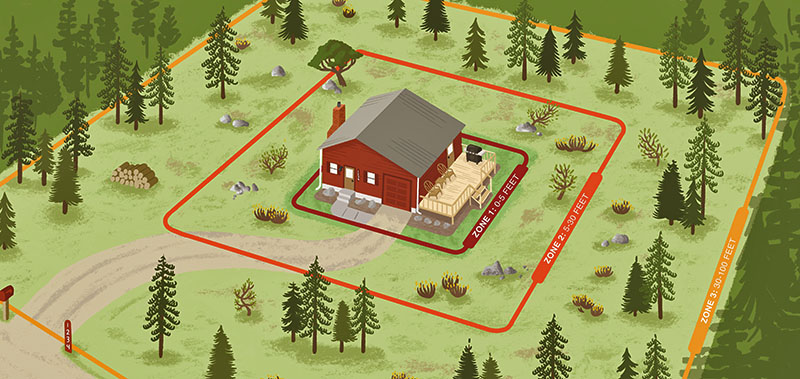
Zone 2 is where the bulk of the vegetation modification takes place, the purpose is to give an approaching fire less fuel to burn, which will help reduce its intensity as it gets nearer to the structure. This zone extends 25 feet, starting at the end of Zone 1. Zones 1 and 2 combined are a minimum of 30 feet. This zone can increase in size depending on the percent of the surrounding slope, as slope becomes steeper, the vegetation must be mitigated at a greater distance to compensate for the heat and wind moving up the slope.
- Trees and shrubs should be thinned so there is at least a 15 foot spacing between the edges of tree crowns. Crown separation is measured from the edge of the branches on one tree to the nearest tree branch on the neighboring tree, not the spacing between the tree trunks. On steeper slopes, allow more space between tree crowns as fire moves faster uphill.
Critical Actions for Zone 2
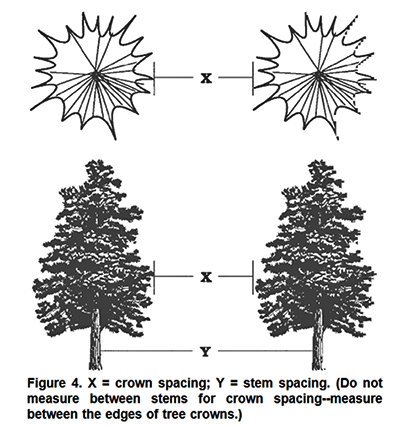 Mow grasses to 4 inches tall or less.
Mow grasses to 4 inches tall or less.- Avoid large accumulations of surface fuels such as logs, branches, slash and mulch.
- Remove enough trees to create at least 15 feet* of space between crowns. Measure from the outermost branch of one tree to the nearest branch on the next tree.
- Small groups of two or three trees may be left in some areas of Zone 2. Spacing of 30 feet* should be maintained between remaining tree groups to ensure fire doesn’t jump from one group to another.
- Remove ladder fuels under remaining trees. This is any vegetation that can bring fire from the ground up into taller fuels.
- Prune tree branches to a height of 6-10 feet from the ground or a third of the total height of the tree, whichever is less.
- Remove stressed, diseased, dead or dying trees and shrubs. This reduces the amount of vegetation available to burn and improves forest health.
- Common ground junipers should be removed whenever possible because they are highly flammable and tend to hold a layer of flammable material beneath them.
- You can keep isolated shrubs in Zone 2, as long as they are not growing under trees. Keep shrubs at least 10 feet* away from the edge of tree branches.
- Periodically prune and maintain shrubs to prevent excessive growth. Remove dead stems annually.
- Spacing between clumps of shrubs should be at least 2 1/2 times* their mature height. Each clump should have a diameter no more than twice the mature height of the vegetation. Example: For shrubs that grow 6 feet tall, space clumps 15 feet apart or more (measured from the edge of the crowns of vegetation clumps). Each clump of these shrubs should not exceed 12 feet in diameter.
* Horizontal spacing recommendations are minimums and can be increased to reduce potential fire behavior, particularly on slopes. Consult a forestry, fire or natural resource professional for guidance with spacing on slopes.
Zone 3 is an area of fuel reduction designed to diminish the intensity (wind, heat, smoke) of any wildfire approaching the structure and to keep the fire on the ground and out of the tree canopy. The width of Zone 3 depends on the slope around the structure. Typically, the zone should extend at least 100 feet from all structures (this includes Zone 1).
It is also a space to make choices that can improve forest health. Healthy forests include trees of multiple ages, sizes, and species, where adequate growing room for the trees is maintained over time. If the distance of 100 feet to the edge of Zone 3 stretches beyond your property lines, it’s encouraged to work with adjoining property owners to complete an appropriate defensible space. If your house is on steep slopes or has certain topographic considerations, this zone may be larger.
Within Zone 3, the following is recommended:
- Mowing grasses is not necessary in Zone 3.
- Watch for hazards associated with ladder fuels. The chance of a surface fire climbing into the trees is reduced in a forest where surface fuels are widely separated and low tree branches are removed.
- Tree crown spacing of 6-10 feet is suggested. Consider creating openings or meadows between small clumps of trees so fire must transition to the ground to keep moving.
- Any approved method of slash treatment is acceptable in this zone, including removal, piling and burning, lop and scatter, or mulching. Lop-and-scatter or mulching treatments should be minimized in favor of treatments that reduce the amount of woody material in the zone. The farther this material is from the home, the better.
The main goal of defensible space is for a wildfire to encounter Zone 3, slow down its rate of movement and decrease its intensity. Then the fire will encounter Zones 1 and 2 where combustible vegetation is minimal, therefore the wildfire cannot make direct contact with the structure and the wind will move the wildfire through the property without too much destruction to the vegetation.
Remember this:
Defensible space is not a onetime activity, it is an annual activity; the homeowner must maintain the property as vegetation continues to grow and leaf litter accumulates.
Learn how to protect your home from wildfire by viewing our Home Ignition Zone Guide (2.7 MB PDF) and call the Grand Junction Field Office at (970) 248-7325 for more assistance.
Additional Information on Wildfire Mitigation and Wildfire Behavior:
- Cheatgrass is a non-native, very flammable grass that prefers areas that have been disturbed. Cheatgrass should be removed or kept to a minimum. For more information, read Cheatgrass and Wildfire (950 KB PDF).
- Below is a selection of YouTube videos that help explain wildfire behavior and how to prevent home ignition:
Things to Consider when Creating a Defensible Space in Western Colorado
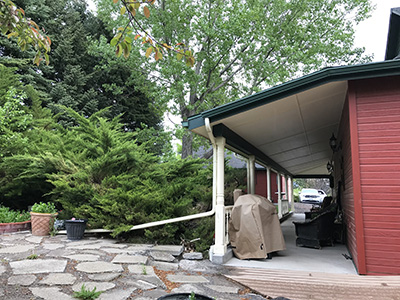 If your property is in piñon-juniper woodlands, thinning to reduce wildfire hazards requires different techniques then thinning in other forest types.
If your property is in piñon-juniper woodlands, thinning to reduce wildfire hazards requires different techniques then thinning in other forest types.
Follow these tips to help reduce your forest’s flammability around your home: Thinning to Meet CSFS Defensible Space Mitigation Standards (25 KB PDF).
In piñon-juniper woodlands, extra precautions also must be taken against attracting the piñon Ips beetle when removing live (green) trees, read this information to prevent attracting the beetle to your property: Slash Management with Regard to Ips Beetle (250 KB PDF).
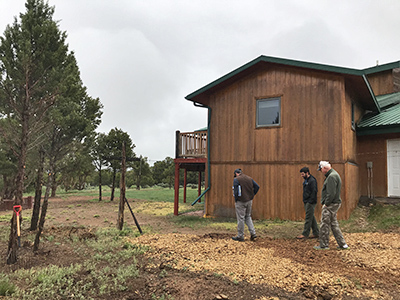 Plants are available that have a lower flammability rating. Check out Low-Flammability Landscape Plants (500 KB PDF) to learn what plants would do well in your area.
Plants are available that have a lower flammability rating. Check out Low-Flammability Landscape Plants (500 KB PDF) to learn what plants would do well in your area.
To determine the flammability of plants you currently have around your home, Firewise Maryland has created a great guide to help landowners: Plant Flammability Key.
Contractors in Western Colorado who specialize in tree removal and defensible space creation are available to help with reducing the vegetation around your home.
For a current list of forestry contractors, please visit our Forest Management page.
Community Wildfire Protection Plans
Community Wildfire Protection Plans (CWPPs) represent the best opportunity we have to address the challenges of the wildland-urban interface (WUI) in a way that brings about comprehensive and locally supported solutions on a community and landscape scale.
Any community can create a CWPP and the Grand Junction Field Office will help! Visit the CSFS CWPP page and call our office with any questions.
Fire Restrictions in Western Colorado
Fire restrictions will vary across the state and by government agency. It is always best to confirm you have the most recent information before burning any material or starting a camp fire.
U.S. Forest Service – Grand Mesa, Uncompahgre and Gunnison National Forests
Mesa County Office of Emergency Management
West Slope Fire Information (Delta, Gunnison, Hinsdale, Montrose, Ouray and San Miguel counties)
Upper Colorado River – U.S. Bureau of Land Management (BLM) (Western Colorado)
Colorado Division Fire Prevention and Control (all of Colorado)
Partners
- U.S. Forest Service – Grand Mesa, Uncompahgre and Gunnison National Forests (GMUG)
- Firewise USA®
- Fire adapted communities
- U.S. BLM
- Grand Junction Field Office (Grand Junction)
- Uncompahgre Field Office (Montrose)
- Two Rivers Wildfire Coalition
- West Region Wildfire Council

